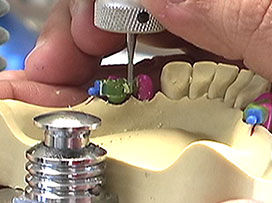We use cookies to make your experience better. To comply with the new e-Privacy directive, we need to ask for your consent to set the cookies. Learn more.
Bredent Attachments System Tips and Techniques
Parallelism:
All Bredent attachments need be to parallel and should be installed using a surveyor and the proper mandrel for the system being used (Example: VKS-SG and OC require the use of the VKS Paralleling Mandrel). Eyeball placement of the patrix is not recommended and any divergence in the attachments will contribute to the reduction of their retentive lifespan. This can cause premature wear of the matrix (female) and patrix (male); as well as improper fit and constant displacement of the prosthesis.

To ensure the trouble-free and long lasting function of the attachments, stability of the removable denture is of the utmost importance.
- Bredent attachments require a circumferential shoulder with a groove on the abutment crown bearing the patrix. It is recommended for this shoulder and groove to be incorporated in the waxing stage using a milling machine or a surveyor. The shoulder rest with groove will receive a lingual arm coming from the partial.
- The lingual arm and shoulder rest seat with a groove prevent displacement of the appliance and keeps attachments free of stress by diverting shear forces down the long axis of the abutment tooth.
- The lingual arm is not retentive, it only provides stability, stress distribution and guidance for patients to insert and remove the prosthesis.
- Failure to provide the lingual arm and rest seat with a groove can result in the patrix (male) breaking completely off of the crown or wear prematurely due to the prosthesis displacing frequently.




We recommend using an alloy that has a minimum of 230 Vickers Hardness or greater. Yellow crown and bridge alloys in the Type III or IV range may require hardening through heat treatment in order to achieve 230 Vickers or more.
Standardized technique for hardening crown and bridge alloys
- Anneal the finished castings by heating and quenching.
- Harden by heating and slow cooling.
- Consult alloy manufacturer for exact temperatures and heat treating details of your specific alloy.
After casting, the castings are divested and sandblasted in the usual manner. They are then finished and porcelainized as usual. Note: Try not to get porcelain on the patrix; and if so, sandblast lightly to remove excess the ceramic material.
Aluminum oxide blasting or glass beading is not recommended as adequate metal surface finishes for the patrices (males). The microscopically rough surfaces created by these methods can erode the Duroplast (thermoplastic) matrices (females) during patient use.
We recommend the use of the Bredent Abraso Fix polishing wheels which are designed to pre-polish freshly sandblasted metal surfaces without reducing material. These are suitable for the polishing of any cast attachment.
When using attachments such as the VKS-SG or OC on crown and bridgework to receive an RPD, we recommend having the crowns and partial fabricated and seated together. However, if they cannot be fabricated and seated together or…if the RPD in an existing SG or OC case is compromised and it needs to be re-done, follow these steps:
- Use Impregum impression material and syringe around the patrices to take the impression
- Purchase the VKS model analogs in the corresponding size of the attachment and insert into ball socket of the impression; flow some hot wax around the analogs to keep them from moving around during the pouring of the model.
- Pour cast as usual
- Remake the RPD
The VKS-SG and OC matrices are not adjustable in any way; if they are modified; then chances are that they will not last very long.
Insertion of the high friction matrices prematurely can cause wear of the matrix and patrix. Remember that the least amount of retention required by the patient is best. All new cases should start with the green or yellow matrix and then, move up one level of retention at a time as needed by the patient.
Attachment prosthesis should be inspected for good tissue adaptation, correct occlusion and overall appearance and function of attachment components
Patients should be instructed not to bite their prosthesis’s into place because it can cause premature wear of the matrices and patrices. Light finger pressure to insert them is best.
Clean abutments and appliances twice daily with a soft brush and toothpaste; make sure excess toothpaste is washed out. Toothpaste can be abrasive and if left inside the matrices, it could cause wear of the patrix as it engages and disengages.
Denture cleaners, especially chlorine based ones are not recommended because they distort plastic components over time (2-3 months)
Patients should remove their prostheses before going to sleep to avoid putting them under bruxing or clenching jaw forces.
A regular dental maintenance schedule (at least every 6 months) should be followed. Attachment prosthesis should be inspected for good tissue adaptation, correct occlusion and overall appearance and function of attachment components.
Current studies from Bredent have shown that in a limited number of patients (1 out of 5000) crystalline deposits can form on natural teeth, dentures, partials and fixed restorations in the oral environment. Usually resulting from poor oral hygiene; these deposits are only visible when appliances are totally dry. Otherwise, almost impossible to detect in the humid oral environment; and they attach themselves to all resin and metallic structures causing severe, trench-like abrasion marks on anything they come in contact with, especially attachment male and female components. All attachments systems are susceptible to this phenomenon and loss of retention can occur if it is not discovered and removed in time.





